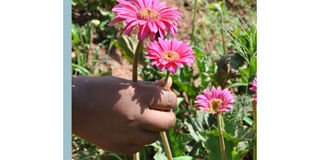Taking proper care of your home plants

Do not choose a plant simply because it looks good, first get to know everything there is to learn about it.
PHOTO/RACHEL MABALA
What you need to know:
- Plants need love and care to thrive, we share how you can take great care of your plant.
I still remember my first plant; it was prickly but beautiful cactus plant. My friend had chosen it not just because it is a symbol of good luck but because she thought it was difficult to kill. I was determined to reward her faith in me with a thriving succulent plant and I took to the task with utmost dedication. I watered it, changed its position often hoping to give it enough light and sun. One morning I woke up to find it all dried up. I broke the news to her and I can still hear my friend wondering incredulously, “Who kills a cactus?”
Gardening is not as peaceful as most gardeners make it look. But you do not necessarily have to have the fabled green thumb either to have a thriving garden; all you need is to understand its basic care.
Sylvia Mukalazi a successful gardener suggests that before you choose a plant first learn more about it. She cautions against choosing a plant simply because you like the way it looks. “The people at the nurseries are usually helpful if you ask the right question. Ask how much effort it will require to keep whatever plant you choose alive. If the level is beyond your capacity it is better to leave it,” she advises. Find out how much sun, water it needs or the type of soil it can thrive in. Does your plant need fertilizers and in what quantity or can it grow without? Every plant has its own unique set of requirements. While there are plenty of across-the-board rules that apply to most plants, you will have the best results and the greatest rate of success when you take the time to learn about each species of plant individually.
Planter material
If your plants are growing in a planter it is important you choose one with care. There are as many planter materials as there are tastes and preferences. Each material provides a unique style and each has its own advantages and disadvantages.
Maureen Atuhumuza a horticulturist notes that clay is one of the more popular materials for planters. Not only do clay planters easily blend in almost every environment but they are also very porous, allowing for excellent air flow to your roots. However, clay is delicate and cracks easily when knocked over. And because of their high porousness, they are not suitable for plants that need a lot of sun because they can dry out rapidly.
Other favourite planter materials are stone and concrete. A concrete planter looks great; they are durable and can brave the harshest weather conditions. “There are concrete planters made from cement and wire mesh available on the market; they have a very classy and professional look, available in many shades and finishes. They however can be quite heavy especially when filled with soil. These should be used for plants that stay in cool areas to avoid excessive heat that is likely to be retained in the material,” she advises. Others types include plastic, wood, melamine, fiberglass and wicker among others.
Plant in the right soil
Mukalazi notes that not every soil supports plant growth. And the condition of your soil will affect the health of your plant. If you are not sure of the condition of your soil she recommends you buy a bag of soil from the nursery because it usually contains extra nutrients or fertilizers that will help your plant stay strong and healthy. “And if you choose to add fertilisers to the soil yourself, be careful because too much of any fertiliser can burn roots, reducing their ability to absorb water and nutrients which reduces their ability fight off diseases,” she cautions.
Water just enough
Atuhumuza says the amount of water can kill or save your plant. “Plants like most living organisms will drown and die if they are given too much water. They will also dry up and die if given little. You need to find the perfect balance for healthy plants. As a rule of thumb, plants with thicker leaves need less water while species those with thin tiny leaves and can dry out quickly,” she says. To tell whether or not your plant needs water, feel the soil, preferably near the edge of the pot. If the soil feels dry it is time to water. If it still feels damp, leave it for a while. Another sign that your plants need watering is if their leaves are turning dry, brown and shriveled.
When you are watering, water from the leaves to take away the dust and residue which will leave your plants clean.
When your plants are dirty, Atuhumuza says you can give them a plant shower. Just get clean water and spray the plants. Do not use harsh materials to clean because they might damage the veins.
Caution: In your effort to show your plant some TLC (tender loving care), please do not go overboard. Some plants such as grasses and other delicate leafed plants can do well without being touched.
Root check
She also suggests regular root check. “Most people forget about the roots but if they are not healthy the plant will die but if the problem is identified early on, your plant has increased chances to make it. Check the roots once a month or at least twice a year depending on the growth rate of your plant,” she says.




